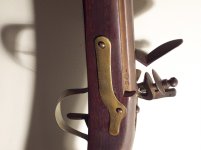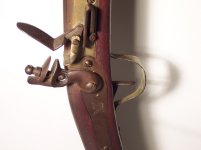Mike Langlais
Inactive
Hello everyone,
first time here, and I was hoping I could get some help in identifying a Flintlock that my grandfather owns. All I know of it's history is that my Great-Grandfather owned it prior and kept it mounted on a wall. On top of the barrel is a stamp that I believe says "Made in Belgium" though part of it is obscured/doublestamped. I've included a few pics of the barrel stamps (right side and left). Total length is about 5 to 5.5' long, with a bore between .5o and .58 caliber. I didn't have any way of accurately measuring it at the time.
My great-grandfather had two flintlocks, one was a replica, the other supposedly genuine, and my grandpa doesn't know which one he has.
I can try to answer any questions you have.
thanks for your help.
Images:
http://phoenixravenwolf.deviantart.com/art/Flintlock-left-si...
http://phoenixravenwolf.deviantart.com/art/Flintlock-right-s...
http://phoenixravenwolf.deviantart.com/art/Flintlock-full-16...
The images are clickable to enlarge to the full size. If you would prefer, I can email them to whomever would like.
Thanks again.
Mike
first time here, and I was hoping I could get some help in identifying a Flintlock that my grandfather owns. All I know of it's history is that my Great-Grandfather owned it prior and kept it mounted on a wall. On top of the barrel is a stamp that I believe says "Made in Belgium" though part of it is obscured/doublestamped. I've included a few pics of the barrel stamps (right side and left). Total length is about 5 to 5.5' long, with a bore between .5o and .58 caliber. I didn't have any way of accurately measuring it at the time.
My great-grandfather had two flintlocks, one was a replica, the other supposedly genuine, and my grandpa doesn't know which one he has.
I can try to answer any questions you have.
thanks for your help.
Images:
http://phoenixravenwolf.deviantart.com/art/Flintlock-left-si...
http://phoenixravenwolf.deviantart.com/art/Flintlock-right-s...
http://phoenixravenwolf.deviantart.com/art/Flintlock-full-16...
The images are clickable to enlarge to the full size. If you would prefer, I can email them to whomever would like.
Thanks again.
Mike



